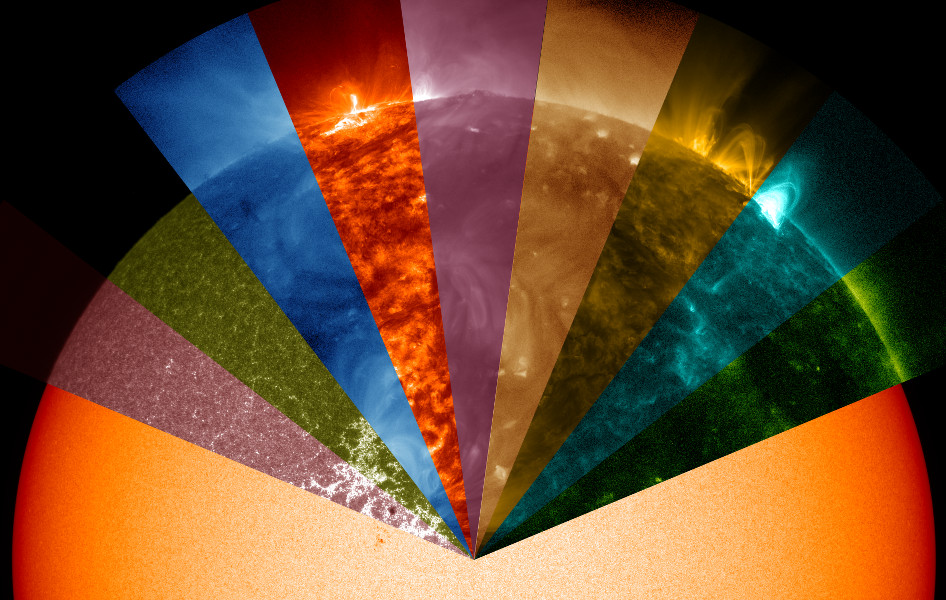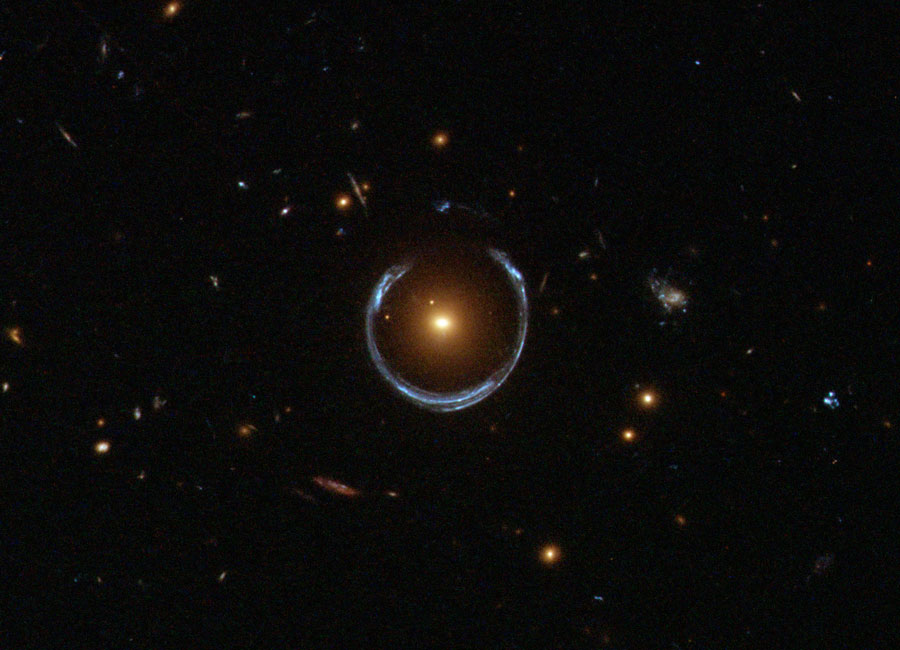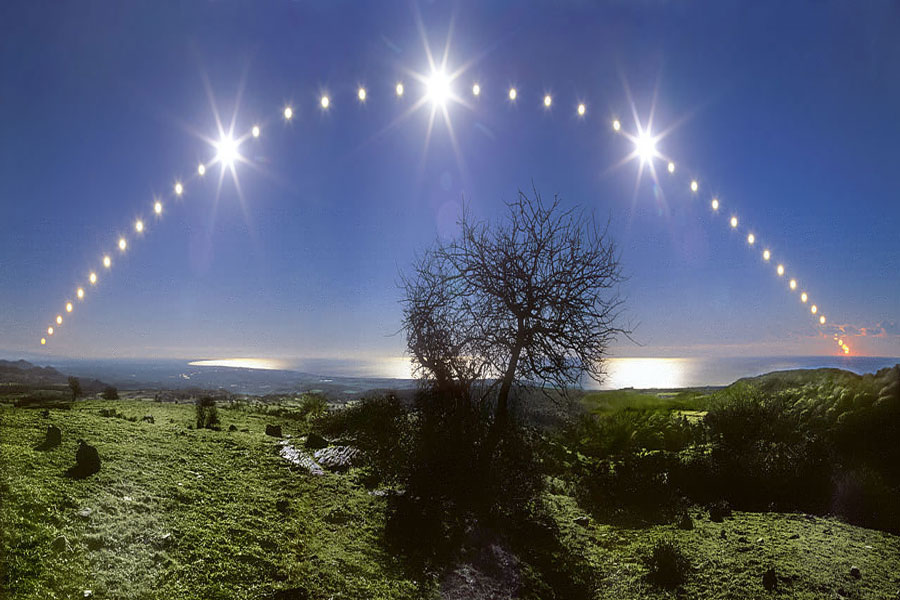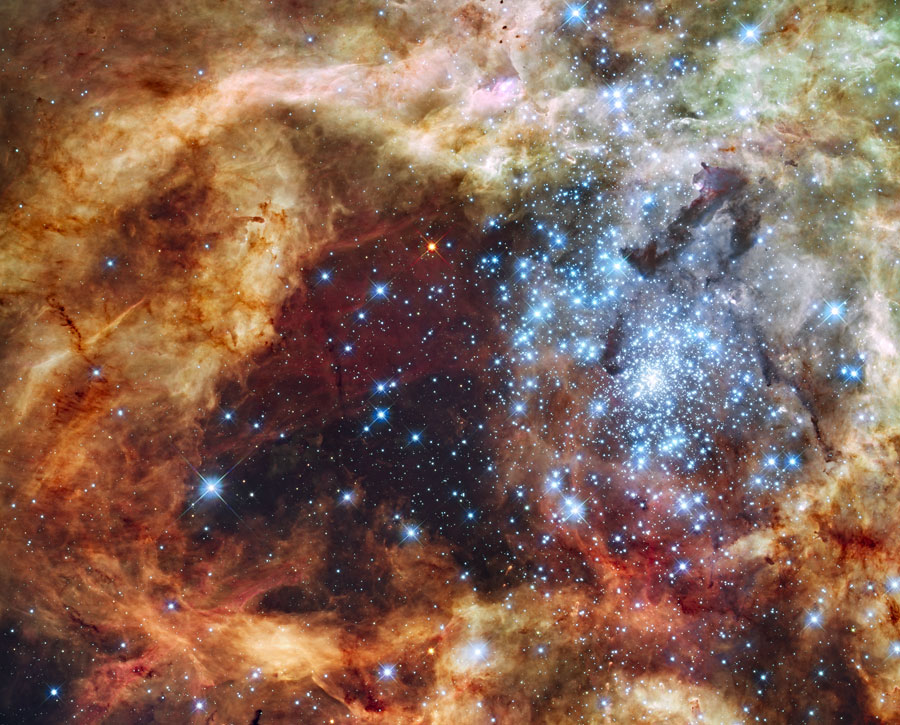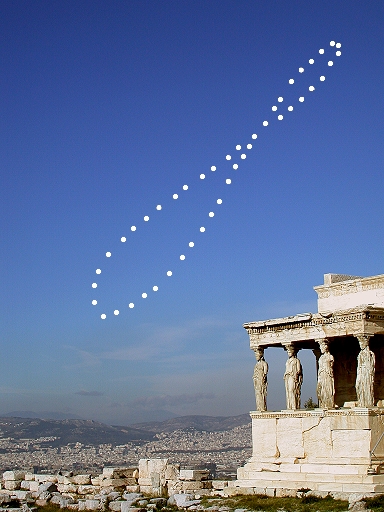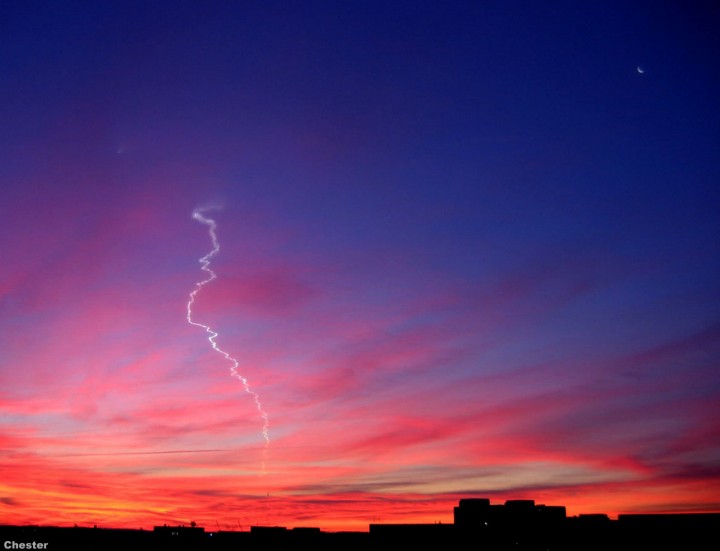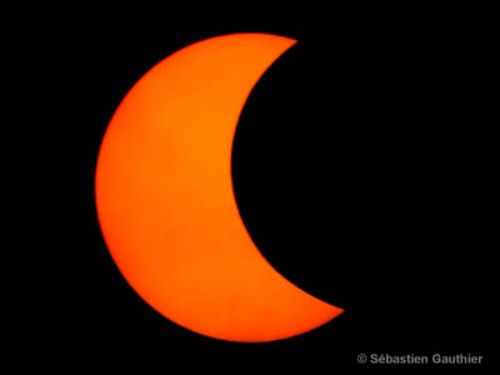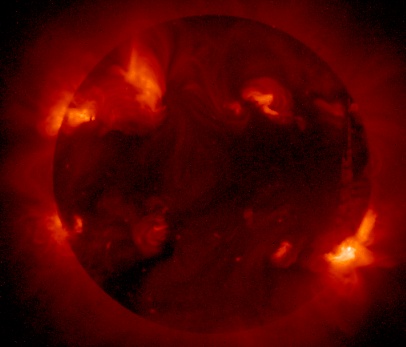| << Previous | Index | Next >> |
2014 Today the solstice occurs at 23:03 Universal Time, the Sun reaching its southernmost declination in planet Earth's sky. Of course, the December solstice marks the beginning of winter in the northern hemisphere and summer in the south. When viewed from northern latitudes, and as shown in the above horizontally compressed image, the Sun will make its lowest arc through the sky along the southern horizon. So in the north, the solstice day has the shortest length of time between sunrise and sunset and fewest hours of daylight. This striking composite image follows the Sun's path through the December solstice day of 2005 in a beautiful blue sky, looking down the Tyrrhenian Sea coast from Santa Severa toward Fiumicino, Italy. The view covers about 115 degrees in 43 separate, well-planned exposures from sunrise to sunset.
2013 Today, the solstice is at 17:11 Universal Time, the Sun reaching the southernmost declination in its yearly journey through planet Earth's sky. The December solstice marks the astronomical beginning of winter in the northern hemisphere and summer in the south. To celebrate, explore this creative visualization of the Sun from visible to extreme ultraviolet wavelengths, using image data from the orbiting Solar Dynamics Observatory (SDO). Against a base image made at a visible wavelengths, the wedge-shaped segments show the solar disk at increasingly shorter ultraviolet and extreme ultraviolet wavelengths. Shown in false-color and rotating in a clockwise direction, the filters decrease in wavelength from 170 nanometers (in pink) through 9.4 nanometers (green). At shorter wavelengths, the altitude and temperature of the regions revealed in the solar atmosphere tend to increase. Bright at visible wavelengths, the solar photosphere looks darker in the ultraviolet, but sunspots glow and bright plasma traces looping magnetic fields. Watch the filters sweep around the solar disk in this animation of SDO's multiwavelength view of the Sun.
2012
2011 What's large and blue and can wrap itself around an entire galaxy? A gravitational lens mirage. Pictured above, the gravity of a luminous red galaxy (LRG) has gravitationally distorted the light from a much more distant blue galaxy. More typically, such light bending results in two discernible images of the distant galaxy, but here the lens alignment is so precise that the background galaxy is distorted into a horseshoe -- a nearly complete ring. Since such a lensing effect was generally predicted in some detail by Albert Einstein over 70 years ago, rings like this are now known as Einstein Rings. Although LRG 3-757 was discovered in 2007 in data from the Sloan Digital Sky Survey (SDSS), the image shown above is a follow-up observation taken with the Hubble Space Telescope's Wide Field Camera 3. Strong gravitational lenses like LRG 3-757 are more than oddities -- their multiple properties allow astronomers to determine the mass and dark matter content of the foreground galaxy lenses.
2010 Today the solstice occurs at 23:38 Universal Time, the Sun reaching its southernmost declination in planet Earth's sky. Of course, the December solstice marks the beginning of winter in the northern hemisphere and summer in the south. When viewed from northern latitudes, and as shown in the above horizontally compressed image, the Sun will make its lowest arc through the sky along the southern horizon. So in the north, the solstice day has the shortest length of time between sunrise and sunset and fewest hours of daylight. This striking composite image follows the Sun's path through the December solstice day of 2005 in a beautiful blue sky, looking down the Tyrrhenian Sea coast from Santa Severa toward Fiumicino, Italy. The view covers about 115 degrees in 43 separate, well-planned exposures from sunrise to sunset.
2009
2008 If you took a picture of the Sun at the same time each day, would it remain in the same position? The answer is no, and the shape traced out by the Sun over the course of a year is called an analemma. The Sun's apparent shift is caused by the Earth's motion around the Sun when combined with the tilt of the Earth's rotation axis. The Sun will appear at its highest point of the analemma during summer and at its lowest during winter. Today, the Winter Solstice day in Earth's northern hemisphere, the Sun is at the bottom of the analemma. Analemmas created from different latitudes would appear at least slightly different, as well as analemmas created at a different time each day. This particular analemma was built up by 46 separate Sun photographs taken during 2003 in Athens, Greece. Pictured in the foreground of this composite image are pillars called the Porch of Maidens, part of the ancient Erechtheum which was completed in 407 BC.
2007 Scroll right and journey from horizon to horizon as your gaze sweeps through the zenith in the night sky over Beg-Meil, France. Recorded on December 13th, the entertaining panorama (image key) covers 210 degrees in 21 separate exposures, beginning on the beach with bright star Sirius rising in the southeast. Look up (pan right) to encounter the nebula rich constellation of Orion and continue on to find the lovely Pleiades star cluster. Farther along, higher in the sky, is the famous Comet Holmes, still gracing the northern hemisphere's night with its remarkable expanding coma. Finally, just before diving into the urban glow from city lights along the northwestern horizon (far right), check out the double star cluster in Perseus and take in the cosmic streak of a bright Geminid Meteor.
2006 Last Saturday, some colorful dawn skies along the US east coast featured the Moon and a Minotaur rocket climbing into low Earth orbit. The 7AM launch of the four stage Air Force Minotaur I rocket took place at NASA's Wallops Flight Facility on Virginia's eastern shore. Looking east, the rocket is visible beyond the top of the twisting exhaust plume in this wide angle view, with the waning crescent Moon at the upper right. The snapshot was taken from Alexandria, Virginia, some 100 miles northwest of Wallops Island. Orbital launches from Wallops have so far been relatively rare, the last two taking place in 1995 and 1985. As a result, many early morning risers reported the unusual spectacle. The rocket's payload was the Air Force Research Laboratory's TacSat-2 satellite and NASA's GeneSat-1 microsatellite.
2005 Does the Sun always rise in the same direction? No. As the seasons change, the direction toward the rising Sun will change, too. The Sun will always rise and set furthest to the south during the day of Winter Solstice, and furthest to the north during Summer Solstice. Today is Winter Solstice, the day of least sunlight in the Northern Hemisphere and of most sunlight in the Southern Hemisphere. In many countries, the Winter Solstice brings a change in season, as it is the first day of winter in the North. The solar heating and stored energy in the Earth's surface and atmosphere is near its lowest during winter, making it usually the coldest months of the year. On the brighter side in the north, daylight hours will increase every day from now until June. Pictured above are the different directions of the rising sun throughout the year above a small town in Greece.
2004 Will the Huygens probe land or splash down? In the next few days, the Cassini spacecraft currently orbiting Saturn will release a probe that will descend toward Saturn's largest moon in mid-January. That moon, Titan, has a surface normally hidden from view by thick methane cloud decks. What the car-sized flying-saucer-shaped probe will find is unknown. Once reaching the surface, Huygens may survive for as long as 150 minutes and take as many as 1,100 images. These images will be beamed up to the passing Cassini mothership for subsequent transmission to a waiting Earth. The Huygens probe is depicted above entering Titan's atmosphere and deploying its parachute. Uncovering the most mysterious moon in the Solar System may reveal a surface so strange that images of it may not be immediately understood.
2003 In a search for massive stars, the Hubble Space Telescope has peered into yet another spectacular region of star formation. This nebula, known as N159, spans over 150 light-years and is located in the neighboring Large Magellanic Cloud galaxy, about 170,000 light years distant. Visible in the above picture are bright newborn stars, dark filaments of dust, and red-glowing hydrogen gas. The aptly named Papillon Nebula (French for butterfly), is the unusual central compact cloud, highlighted in the inset. Reasons for the bipolar shape of the Papillon Nebula are currently unknown, but might indicate the presence of unseen high-mass stars and a thick gaseous disk.
2002 Aloha and Season's greetings! On December 22nd, at 01:14 Universal Time (December 21, 3:14pm Hawaii-Aleutian Standard Time), the Sun reaches its southernmost point in planet Earth's sky marking the final season change for the year 2002. In celebration, consider this delightfully detailed, brightly colored image of the active Sun. From the EIT instrument onboard the space-based SOHO observatory, the tantalizing picture is a false-color composite of three images all made in extreme ultraviolet light. Each individual image highlights a different temperature regime in the upper solar atmosphere and was assigned a specific color; red at 2 million, green at 1.5 million, and blue at 1 million degrees C. The combined image shows bright active regions strewn across the solar disk, which would otherwise appear as dark groups of sunspots in visible light images, along with some magnificent plasma loops and an immense prominence at the righthand solar limb.
2001 Welcome to the December Solstice, first day of winter in the north and summer in the southern hemisphere of planet Earth. Today the Sun reaches its southernmost declination in the sky at 19:21 Universal Time. Just a short week ago, as the Sun approached the end of its annual journey south, it was eclipsed by the Moon. Observers in Costa Rica witnessed a fleeting annular eclipse with the Moon surrounded by a dramatic bright ring as it covered about 96 percent of the visible solar surface during the maximum phase. But from most of the Americas this eclipse was partial ... and skies were often partially cloudy! Public Television Engineer Stan Richard captured this view near Des Moines, Iowa, USA. Taken close to eclipse maximum for his location, the sharp, silhouetted edge of the Moon is visible through the clouds in the lower left quadrant of the solar disk.
2000 Today the Sun reaches its southernmost point in planet Earth's sky at 13:37 UT. This celestial event is known as a solstice, marking the beginning of Summer in the Southern Hemisphere and Winter in the North. But this year, the solstice will be followed, on December 25th, by another geocentric celestial event -- the last eclipse of the millennium! The Christmas day eclipse will only be a partial one as the silhouetted disk of the Moon obscures the Sun's edge. Visible from much of Canada, The United States and Mexico, the appearance of the partially eclipsed Sun might remind you of the last holiday cookie you took a bite from. Still, the exact timing and degree of the eclipse will depend very much on your location. This image, from an annular eclipse in 1994, shows the lunar disk covering around 55% of the Sun's diameter. It is representative of what could be seen from Washington D. C. during the December 25 eclipse maximum which, for that location, occurs at 12:41 PM ET. As always, if you view the eclipse be extremely careful to protect your eyes.
1999 X-ray astronomy entered a golden age earlier this month with the successful launch of the X-ray Multi-Mirror (XMM) satellite. XMM's three huge telescope barrels each hold 58 concentric cylindrical mirrors, together totaling a surface area rivaling a tennis court. Each mirror has been gold plated to less than one-millimeter thickness to reflect normally penetrating X-rays. ESA's XMM joins NASA's Chandra X-ray Observatory as leading observatories in X-ray astronomy. The XMM satellite also carries a small optical and ultraviolet telescope. XMM's unusually elliptical orbit around the Earth peaks nearly one-third of the way to the Moon. XMM's observing program during its planned two-year mission includes monitoring the hot surroundings of black holes, the fiery regions surrounding the centers of galaxies, the mysterious X-ray background light that appears to come from all directions, and the hot gas that glows between galaxies and stars.
1998 The solstice occurs today at 8:56 PM Eastern Standard Time. At the solstice the sun reaches its most southerly position in the sky and winter begins for the Northern Hemisphere while summer starts South of the Equator. This false-color image of the sun was made about 48 hours before the solstice in the light of soft (lower energy) X-rays by a telescope on board the space-based Yohkho solar observatory. The normally bright, visible solar surface or photosphere appears dark in X-ray light while active regions in the solar corona which lie above the photosphere are particularly X-ray bright. Solar photospheric temperatures are about 6,000 degrees C. but the X-ray bright coronal regions have temperatures of millions of degrees. Why is the sun's corona so hot?
1997 Today is the Winter Solstice, the shortest day of the year in the Northern Hemisphere. The yearly cycle of Seasons on planet Earth once again finds the Sun at its lowest point in the Northern Sky. The Sun's own 11 year cycle of activity is progressing toward a maximum which will occur in 2000-2001. This image of the Sun in the light of ionized Helium was recorded by the space-based SOHO observatory only three days ago and shows many prominences and active regions.
1996 Today is the Winter Solstice for 1996. After steadily sinking in Northern Hemisphere skies, the Sun is now at its lowest declination - marking the first day of Northern Winter (but Southern Summer!). The Earth is actually closer to the Sun during this season, a fact not usually appreciated by those who dwell on the planet's Northern half. Two days ago, the EIT camera onboard the SOHO spacecraft recorded this image of the Sun in the light of highly ionized Iron atoms. This extreme ultraviolet picture emphasizes magnetic field lines and active regions in the hot plasma above the solar surface. For today's Solar images at many wavelengths, check out the Solar Data Analysis Center's web site.
1995
| << Previous | Index | Next >> |

